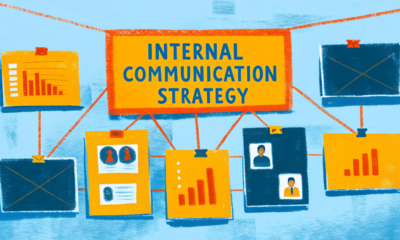Collaboration
Collaboration in Remote Teams: 5 Things That Make a Difference

Working from home is a comparatively new trend that started to gather momentum with the advent of digital technologies. The previous five years saw a 44% surge in remote employment, which is explained by two major factors.
The first is the growing mobility of the workforce, 40% of which are expected to go exceedingly mobile globally by 2022. In the developed countries, this ratio is likely to reach the astounding three-fourths.
No less fundamental is the impact of COVID-19. Many companies in most various industries were simply forced to go remote just to keep their head above the water and continue providing services in the global pandemic conditions.
With the remote format of work becoming even more widespread, it is a must for companies to find their way around remote team management. Let’s dive a bit deeper into the topic and tackle some essential nuances.
Working remotely: a closer view
Yet another reason for remote becoming a common format of work is the employees’ increasing desire for more flexibility. Half of them are ready to flock to the enterprises that offer this perk and 85% of the latter report a productivity boost after the adoption of remote work model.
Some industries are remarkably suitable for this policy, so close to two-thirds of American IT companies have set up remote tech teams. Others are still weighing up the pros and cons of this approach.
The benefits of working in a remote team seem to be obvious. Besides greater productivity mentioned above, working remotely attracts employees with better expertise who tend to spend up to 80% of their working time in this mode.
The focus on workplace flexibility also allows accommodating various working styles and encourages practicing different task-solution approaches than those they would adopt in the office.

And you wouldn’t need an office anyway with its costly equipment, facilities, and rent expenditures – the factor that can be crucial in the cash-strapped times of the all-out belt-tightening. Moreover, working remotely is a chance to hone employees’ collaboration skills and increase their culture fit awareness.
The realization of numerous assets remote work brings has ushered major shifts in the labor organization in many countries. For example, statistics show that 22% of Americans work exclusively from home, and almost half of the workforce participates in remote work projects.
However, being part of a remote team isn’t just cakes and ale. The limited amount of face-to-face communication may result in employees feeling isolated from the rest of the gang, especially if they hail from different time zones. Other potential pitfalls include extensive reliance on the sometimes fickle sense of self-motivation and third-party software that can fail.
As Harvard Business Review argues, 75% of remote teams have problems with keeping to the schedule, conforming to specifications (including corporate goals alignment), staying within the budget, and meeting the expectations of customers.
These inadequacies typically stem from collaboration issues, which is a cornerstone of any remote team’s successful performance. How come managers miscarry in maintaining collaboration among the staff? The answer is simple: they lack awareness of the big differences between remote and co-located team collaboration.
Ensuring remote team collaboration: aspects to focus on
There are 5 distinctive features that display contrast in collaboration within remote teams and collaboration practiced among co-located staff.
1. Peremptory over-communication
Remember that your team does not work together in the same office where they can easily share the latest news and stay connected. That’s why the efficiency of the remote team is in your communication efforts. If you succeed, you will guarantee that your personnel is on the same page. How could this be achieved?
- Realize that communication within remote teams can be both synchronous and asynchronous. The former is exercised through phone calls or live chats, and occasionally via video calls or meetings. It is the right option if prompt action is imperative, some questions demand an immediate answer, or an adequate problem solution is expected to be attained by brainstorming.
However, the typical type of communication between people in different countries and time zones is the asynchronous one, when there is a lag between messages sent back and forth. It is effected via email, updates, and project management platforms.
Each of these types should be regulated both in terms of purpose and channels used. The latter are better to be limited in number, otherwise communication becomes chaotic.
- Set communication rules. It can be done in the form of a manual that will inform the employees about the cases when certain communication media are used, as well as offer insight in every team member’s working style and personal preferences.
Remote communication is often devoid of body language and intonation cues, which requires additional efforts on the part of participants to convey or interpret the message correctly. Everybody should try to be clear in the messages they send. Otherwise, their colleagues will waste their time trying to guess what their colleagues may feel, think, and do in routine working situations. This will lead to frustration and unintended downtime.

- Keep the instructions as clear as possible. Brevity isn’t the synonym of clarity. Don’t imagine that by using fewer words you will succeed in getting the message through. This is especially important for newbies on your team. By issuing foolproof and logically arranged directives you will avoid misinterpretation. Visualizing assignments work particularly well, so diagrams and charts should become the staple of your communication style.
- Don’t overdo it with the amount of communication. If you inform your employees about a task by email, then text the same thing, and later call them on the phone to make sure they got your two previous messages, you are definitely abusing access channels and annoying the staff. Approach the volume of communication with caution.
- Provide your employees with a nook for casual talk. Adding some informality is always good for team morale. In a real office, it is the proverbial water cooler where people meet to chat about non-work-related things, which allows them to get to know each other better. Remote teams should have a virtual venue of this kind as a team-building factor.
However, it is important to mind the cultural differences between employees from various countries trying to keep communication informal. People from Asia (especially from the Middle East) are more inclined to maintain a more rigid communication style while employees from Europe and America tend to be quite folksy in such intercommunion.
There are sensitive topics (like politics, religion, human rights, wars) or personal issues (for instance, romances) that should be avoided no matter what region people who work at your virtual office hail from.
2. Extended use of collaborative software
Whereas in a conventional office environment using collaborative software is important, for remote teams it is vital. In fact, it is these collaborative tools that make remote work possible. Unfortunately, many managers don’t realize it, so more than 40% of all remote teams never get further than Skype and Facebook messenger.
However, the IT world doesn’t stay put, so there are dozens of tools available in the market. There are collaborative tools like:
- Figma – a highly intuitive solution for collaborative design where teams can throw their ideas together and test them out in one place. Figma offers a number of advanced design tools on top of many common design features – all available both via desktop and mobile.
- Invision – an utterly intuitive, fast, and convenient application for interconnecting a full-on design workflow for the team. It is cloud-based, secure, very diverse in terms of design capabilities for fast and elaborate iterations, tests, and brainstorms.
- Miro – a great popular collaborative platform for whiteboarding that is focused on team brainstorming activities. There are convenient templates, asynchronous teamwork whiteboards, canvases, integrations, and more.
- Mural – a collaborative workspace platform with a large focus on working with visuals. From planning to brainstorming to design and evaluation – the platform can be efficiently used for full-cycle design of projects of any scale and complexity.
The rapid growth in the number of smartphone users has brought forth mobile apps that serve the same purpose.
3. Utmost flexibility
Having people from different time zones on your team is a real challenge because managers should display ingenuity in trying to bring them together. The minimum overlap in working time between them should be at least one hour.
If that is not doable, you should make sure messages are read and addressed as soon as possible, otherwise overall team productivity will plummet. Software tools will help you track what time it is where a certain employee is located and avoid scheduling projects on a national holiday in that country.
Even if the difference in time is just a couple of hours, schedules still require adjustment. Don’t expect your late evening messages to be responded to instantly: the team members aren’t obliged to be available 24/7. However, it is advisable to make daily check-ins a must.
Thus, you will succeed in creating the feeling of a single unit despite the fact that its participants are physically separated. And it will make it easier to keep track of the progress and detect any problems your employees might encounter.
If you’re trying out a new process or onboarding a new team member, we recommend using training videos. Especially since you’re working remotely. This will help build company culture and communicate concepts clearly.
4. Clear expectations and accountability
Remote work demands a structured approach to responsibilities. Without it, tasks may be misunderstood, delayed, or deprioritized. To prevent this, ensure that every team member knows exactly what is expected of them and how their work contributes to shared goals.
Define objectives, deadlines, and performance indicators upfront. Project management tools like Asana, Trello, or ClickUp help assign tasks, set priorities, and track progress transparently. A structured approach minimizes confusion and keeps everyone aligned.
Regular check-ins ensure accountability without micromanaging. Encourage employees to share updates, ask questions, and highlight challenges. This creates a sense of ownership and keeps projects on course. A well-defined system of expectations makes remote teams more efficient and self-sufficient.
5. Maintaining work-life balance
While remote work offers flexibility, it can also blur the lines between professional and personal life. If left unchecked, this can lead to burnout and declining motivation. A clear structure is essential to avoid these pitfalls.
Encourage employees to set defined working hours and stick to a routine. Managers should lead by example, respecting time boundaries, scheduling meetings thoughtfully, and promoting regular breaks. Providing mental health resources or organizing informal virtual gatherings can also help foster engagement and well-being.
A balanced team is a productive one. By prioritizing well-being, you ensure that employees remain motivated, connected, and capable of delivering their best work.
Conclusion
The COVID-19 pandemic accelerated the shift to remote work, forcing businesses and employees alike to rethink their work habits. Now, as we move into 2025, remote and hybrid work are no longer just a temporary response – they are reshaping the future of work itself.
With 56% of companies adopting hybrid models and 73% of employees preferring remote-first environments, collaboration tools and team rituals have become critical to success. New technologies such as AI-driven project management platforms, asynchronous video updates, and virtual whiteboards are helping bridge time zones and streamline communication.
But as forward-thinking organizations embrace these tools, they also recognize that remote collaboration is not just a technical challenge – it’s a cultural one. Companies are embedding async-first mindsets, reimagining onboarding processes, and investing in digital body language training to strengthen communication and collaboration.
The latest trend includes the introduction of “focus hours” where notifications pause, allowing for deep work and reducing burnout. These steps reflect the evolving needs of remote teams as they strive for balance and efficiency.
While technology plays a significant role in facilitating remote work, creating a strong collaborative culture is equally important. By emphasizing communication, flexibility, and intentional tools, companies can ensure their remote teams stay connected, productive, and engaged in the dynamic future of work.
Collaboration
4 Common Problems of Virtual Teams are Solved

Low-stress level, no commute, no shoes, PJs only, spending more time with family and friends, and so much more. Sounds neat right? According to some studies, remote work has brought higher productivity and a more positive work-life balance since the beginning of the pandemic. However, it’s not all rainbows and butterflies, is it? We have been facing some challenges, to say the least. We struggle with unplugging ourselves once the work is done for the day, we need our office gossip, and even though we don’t need to wear shoes, we still kinda miss them. Many problems can appear when we are managing virtual teams. However, does that mean we cannot ace a video meeting or have the same level of communication with our teammates as we did before? Never! All we have to do is get our hands to the right collaboration tools to manage our virtual teams. I give to you the solutions to the most common problems we’ve faced working from home. Trust me, it really is as easy as pie!
1. Communication breakdown: it’s not all about messages — it’s about meaning
The one most reported problem of remote teams is communication — or the lack of it. But it has nothing to do with missed messages. It has everything to do with lost context.
When you communicate face-to-face, 70–90% of what you intend is communicated through body language, tone of voice, and facial expressions. Remote workers lack that level. An urgent message meant to be productive will be cold. A wait in responding will be perceived as not caring.
That’s why business communications tools like Chanty, Google Chat, and GoToMeeting aren’t nice-to-haves, they’re must-haves. They facilitate teams to communicate in real-time, clarify their communication, and utilize richer media like voice and video. Still, the best tool is nothing without a shared communication culture.
HR comes into play here. Get teams to figure out how they communicate: messaging vs. meeting, how they handle urgency, and what “offline” means. Prioritize making voice notes and camera-on calls the new normal to bring back that human feel.
Communication isn’t only about words. It’s about being heard — and feeling connected.
2. Collaboration without clarity: the hidden cost of scattered work
In an office, things naturally tend to overlap. You stretch over a desk. You cut off someone at the coffee machine. You interpret a face at a brainstorming session.
In virtual teams, it doesn’t happen. And without the proper tools, folks will naturally feel like they’re working in solitude — despite being part of a team.
This is where Google Workspace, Microsoft 365, Dropbox, and OneDrive come in. These apps are not simply storage devices — they create a virtual workspace where collaborators can work together. Teams can work together on docs, comment in real-time, and have one source of truth.
But what really matters is psychological safety. If employees don’t feel free to give each other working drafts or ask for help, technology can’t fix that. HR leaders must create a space where collaboration means learning alongside one another, not just working alongside one another.
Technology reduces the friction. But humans reduce the fear. That’s how collaboration thrives.
3. Remote project confusion: why visibility matters more than ever
Without structure, remote projects can drift. Deadlines are missed. Jobs get blurry. Team members do not know what others are doing — or what they must do.
Project management tools like Asana, Jira, Basecamp, and SmartTask bring much-needed discipline. They break goals into doable pieces. They delegate tasks. They provide timelines and certainty.
But aside from task management, these sites are emotional clarity tools. When everyone can see who’s working on what, stress goes down. Nobody feels like they’re doing it all themselves. Nobody feels ignored. Transparency is peace of mind.
For HR, it’s a golden opportunity. Utilize these tools not just for productivity — but for inclusion. A reserved junior team member during meetings can spring to life when they are given clear guidance in a task board. A mute struggler might reveal to us their stress in overdue assignments.
Project management tools have secrets. Savvy HR teams listen intently.
4. Time and productivity tracking: from surveillance to self-awareness
Time tracking is one of the more controversial aspects of remote work. Done badly, it’s intrusive. Done well, it’s an amazing wellness and performance tool.
TimeDoctor, Hivedesk, Toggl, and PomoDone are some of the applications that enable teams to see how they spend their time. They show data on attention, idleness, and task-switching. To remote teams, this isn’t accountability — it’s awareness.
Most remote workers struggle to “switch off.” They work longer, take shorter breaks, and quietly burn out. HR can use time-tracking data not as a punisher, but as a protector. Recognizing overwork early is an act of care.
Furthermore, these tools empower people. People can look at when they’re most productive, or where they drift off course. They can set their own schedules, and build better habits.
The true value isn’t in tracking time — it’s in getting time to work more effectively for individuals.
Final Thought
No matter how many tools you bring on board, virtual teams will fail if their human needs are not met. The need to connect. To be seen. To understand. To trust.
Which makes HR’s role so critical. You’re not just choosing software —you’re developing culture. When you combine great tools with compassionate leadership, you don’t just solve issues — you create an environment where remote doesn’t equal removed.
Because in the end, remote teams don’t succeed because of technology.
They succeed because they care.
Collaboration
10 Pros and Cons of Working Remotely

Work-from-home arrangements are most successful when employers set clear parameters and invest in technology, such as videoconferencing, to help remote personnel feel like they are part of the team, – McDonald
Remote working, working-at-home, telecommuting, and any other similar variations of terms that describe working outside the walls of a traditional office, are getting increased popularity in recent years. Before Covid 19 working from home was a luxury that many of us dreamed of. Seeing pictures of remote workers in some distant places was something that we all wished for (at least I know I did). But let’s be real. Not all that glitters is gold. Working from home has some pitfalls as well.
There are many studies and statistics that favor both ways but together with my team, we decided to make a pros and cons list that will take you in and help you investigate this way of working, letting you weigh the advantages and disadvantages of the same.
The psychological and practical benefits of remote work
Let’s be honest — commuting five days a week to gaze at fluorescent lights while battling back-office gossip and surprise meetings isn’t necessarily a productivity dream. Remote work isn’t a trend — it’s a work life upgrade. And no, not because you can go to meetings in your pajamas (although we wouldn’t judge either).
This is what really makes remote work a game changer — for employees and HR teams.
1. You might actually get more done
Working remotely usually means fewer distractions. No watercooler conversation, no spontaneous 45-minute “quick syncs,” and none whatsoever heating fish in the break room.
- How it works: When you’re in charge of your surroundings, you focus more. It’s not anecdotal— psychologists call this lower cognitive load. Your brain isn’t spending energy repressing distractions.
- HR tip: Time to move beyond “Are they online?” to “Did the work get done well?” Focus on results. Trust trumps micromanagement.
2. Autonomy = Motivation
When people have control over how, when, and where they get their work done, magic happens. Self-Determination Theory (Deci & Ryan) is a reminder that autonomy is a strong psychological driver of motivation and engagement. In plain English? People want to be trusted adults.
- In the wild: Remote workers are more likely to feel happy to be responsible — not less. When employees take ownership, they’re apt to deliver.
- HR tip: Grant autonomy, but don’t lose sight of the map. Flexible policies work best alongside clearly set goals and accountability. Freedom thrives with structure — not chaos.
3. Work-life fit wins over work-life “balance”
“Balance” is such a misnomer, as if the work and life are two even weights on the scale. Come on — it’s more like thrashing about with fiery torches. Remote work allows us to glide between roles so seamlessly: parent, partner, pro.
- Psychological perk: It enhances cognitive flexibility and reduces role conflict. In other words: fewer meltdowns between meetings and school runs.
- HR tip: Foster healthy boundaries. Asynchronous options and thoughtful communication windows prevent burnout while keeping the momentum going.
4. No commute = time (and sanity) regained
Let’s do the math. If your one-way commute was 45 minutes, that’s 90 minutes a day—7.5 hours a week. That’s nearly a whole workday stuck in traffic or wedged between strangers on public transit.
- In practice: People use that time to sleep more, eat well, exercise, or spend time with loved ones. All of which results in better work performance.
- HR tip: Sponsor wellness initiatives that capitalize on this gained time. Maybe offer fitness app stipends or reward morning mindfulness routines.
5. A Personalized workspace reduces daily stress
Office thermostats are the holiest workplace battleground. In your own home, you can finally tailor your seat height, control the volume, and sport fuzzy socks without worry.
- Science claims: Reducing “micro-stressors” (like ambient noise or inadequate lighting) supports emotional control and cognitive concentration.
- HR tip: Don’t simply send a laptop. Offer ergonomic advice, remote office stipends, or even workspace setup courses. Help people craft a space where they can actually thrive.
6. Alignment with natural productivity rhythms
Some of us are most productive at 6 a.m. Others discover their creative rhythm after dinner. Chronobiology confirms: people have different natural rhythms. And no, early risers aren’t “better workers” — they’re just wired differently.
- Real-world win: Writers, coders, and designers often say their best work happens outside the 9–5. Letting people match tasks with energy leads to more “flow” and better output.
- HR tip: Embrace results over rigid hours. Define collaboration windows, but let people control when they dive into deep work. You’ll be surprised at the quality that comes out of a 10 p.m. burst of genius.
7. Improved retention and organizational commitment
If people feel they’re trusted, respected, and able to manage their own lives, they’ll stay around. Happiness isn’t an amenity — it’s a retention device.
- Brain boost: Happy workers are healthier, more engaged, and more productive. It’s basic psychology — having control reduces stress.
- HR tip: Offering remote opportunities and flexible work schedules makes your company’s employer reputation shine. It’s no longer an incentive — it’s the standard.
The quiet challenges of working remote: What we don’t talk about enough
Remote work can be empowering — but it’s not always easy. While convenience and adaptability are the touted benefits, many remote workers struggle with issues that quietly undermine focus, engagement, and productivity. Some are personal. Some are structural. Either way, they’re real — and HR leaders need to see them if they want to make remote work truly work.
Here’s a closer, more honest look at why remote work is difficult—and how it isn’t.
1. Lack of structure can derail your day
Without the outside rhythm of office life, it’s easy to get in late, take too many breaks, or succumb to multitasking wicked habits. That much freedom is disorienting. Projects are delayed. Focus drifts. The line between “working” and just sitting in front of a screen becomes muddled quickly.
- Why it happens: Our brains need context and environmental cues to stay task mode. Working in bed or jumping straight from breakfast to meetings can lead to decision fatigue and confusion.
- What helps: Morning routines, blocks of time, and shutdown ceremonies. HR can step in with digital calendars, self-management training, or apps that allow employees to schedule their days with purpose — not anxiety.
2. Loneliness isn’t just emotional — it’s cognitive
Yes, home working makes room. But excessive isolation depletes its benefits. Studies reveal that loneliness engages the same brain mechanisms as physical pain. Over time, loneliness anaesthetises the mind, causes reduced motivation, and increases stress.
Even introverts report they feel a kind of “post-slow disconnection” from their company culture and team. And when lines between home and work begin to blur, it’s easy to just continue working past dinner time — not because you’re being productive, but because there is no off-switch. And so the line blurs even further.
- What helps: Authentic connection — not forced “fun.” HR can create room for real moments: peer sharing, learning circles between peers, or relaxed check-ins human and not required. Encourage hard stop times and authentic lunch breaks, too.
3. Visibility is a real problem
When no one sees your work, it’s natural to question whether it makes a difference. For remote workers, that “out of sight, out of mind” effect is more than intuition. It’s an obstacle to visibility, project work, or career advancement.
- Mind over matter: Motivation theories like Drive by Daniel Pink posit that advancement and acknowledgment are key to motivation. When feedback disappears, so does motivation.
- What helps: Maintain an achievement log. Send regular (but short) reports. Managers have to be trained by the HR function to hold people accountable for results, not effort. Peer feedback and formal performance reviews help contain bias.
4. Not all home offices are equal
One employee might have a bright office and noise-cancelling headphones. Another could be clacking away in a shared living room or splitting time caregiving in the background. Remote work isn’t one-size-fits-all — and when the setup isn’t optimized, performance and well-being suffer.
For some employees, particularly those with caregiving responsibilities, disabilities, or tiny spaces, remote work creates friction, not freedom.
- What helps: HR must touch base on working conditions often, not just on productivity. Offer coworking allowances, ergonomic gear, or hybrid flexibility to those in need of a new set-up. This isn’t logistics — it’s inclusion.
5. Communication gets hefty — and sometimes off the target
Remote teams rely on text, video, and scheduled syncs. That’s work. Tone is lost. Slack is overwhelming. Zoom is exhausting. Without low-stakes moments — like those spent in the hallway or lunchroom — collaboration becomes less adaptive and more transactional.
- Why it matters: Improvisational communication drives creativity. Without it, groups tend to work in silos, and problem-solving happens slower.
- What helps: Implement async-first workflows. Use tools like Loom, Notion, or update recordings to cut down on live meetings. Reward for clarity over speed. HR can shape these by modeling them in leadership teams and documentation practices.
Remote work: ideal in theory, challenging in reality
So home working is the perfect idea — no daily commute, flexible working hours, your own coffee. But this until you experience the reality, and remote work has very real challenges: distractions, loneliness, blurred boundaries, and the sense of invisibility.
Without routine, days become chaotic. Without informal conversation, collaboration breaks down. And not everybody has a quiet, comfortable home office. For many, working remotely can blur the line between independence and burnout.
But here’s the good news: these aren’t personal deficits — these are fixable design problems. With the right support, remote work can work.
HR teams have a responsibility to perform. It’s not just a question of offering remote choices —it’s about creating the appropriate arrangement. That means:
- Prioritizing outcomes, not time spent on the web
- Enabling breaks and clear-cut closing times
- Providing instruments, touch-bases, and adaptable customs
- Empowering managers to practice trust, not command
Remote work isn’t going away. But if we’re ever going to make it a success in the long run, we must get better at how we facilitate it.
Collaboration
Top 6 Financial Tips Every SaaS Founder Should Know

Starting your own software as a service (SaaS) business is an appealing way to become an entrepreneur. Just come up with your software solution, deploy it, and become indispensable to fellow business owners everywhere — right?
Of course, it’s never that simple. Coming up with and creating your software is the easy part. The hard part is turning your idea into an actual business that enough customers are willing to pay for.
With that in mind, once they finalize their business concept, SaaS founders need to immediately turn their attention to their business’s finances. Building a solvent business model depends on you figuring out the numbers early.
Not sure where to start? Here are six financial tips every SaaS should keep in mind when building out their business.
Validate your idea before committing real funds
Lots of articles on the web will convince you that all you need to start your SaaS or other ecommerce business is an MVP — minimum viable product — that you can start selling. You can always tweak your MVP later as you garner feedback and experience.
Even spending that much of your resources and time, however, can be wasteful. If you build an MVP without a real understanding of whether people will pay for it, you’re essentially throwing money away unless you’re lucky enough to strike gold on your first pass.
You don’t need to build your software until you can demonstrate interest from potential customers. To measure that interest, use landing pages to gauge whether people want to learn more about your idea.
The process is fairly simple:
- Set up several versions of a landing page describing what your software does, how it works better than that of competitors, how much it costs, and other pertinent info that can fit “above the fold” of the page. Use a service like Unbounce or Instapage to set up A/B tests.
- Spend a few bucks on advertisements on Google and Facebook, drawing the attention of users outside your inner circle.
- Test to see how many not only click your ads, but complete your “call to action” (CTA) on each page, such as signing up for the company newsletter, or gaining “early access” to the product.
- Continue to tweak and test your landing pages for optimal copy, page layout, and CTAs until you’re confident you are doing the best job possible marketing your software.
If your CVR (conversion rate, or the percentage of people who complete your call to action after clicking your ad) is higher than a few percentage points (2% on mobile, 4% on desktop), you’ve got enough data to move ahead and build out your service with the confidence that people are willing to pay for your solution, and you itself can increase your business valuation. Another thing that can help improve your finances and the quality of your products is bottom-up budgeting.
Learn and track the important SaaS metrics
Lots of businesses know they need to hit certain metrics in order to remain profitable and keep the company going. Lots of these metrics are the same across the board, for almost every business — CVR, for example.
If you’re wondering what is the purpose of a business plan, it’s to provide a clear roadmap for your business’s strategy, finances, and goals, helping guide decisions and attract investors.
When writing your business plan — a must-have document for a business at any stage — keep in mind the following metrics and how you plan to perform well on each of them:
- LTV: Lifetime value, or a prediction of the net profit you’ll get out of your relationship with a customer.
- CAC: Customer acquisition cost, or the total cost of turning someone from a lead to a paying customer. Things like the cost of running an ad campaign, or how much you spend on CRM software, is factored into this metric.
- MRR: Monthly recurring revenue is the income a company can reliably expect every month.
- ARR: Annual recurring revenue is the income a company can reliably expect each year.
- ARPA: Average revenue per account, or your monthly or yearly recurring revenue divided by the number of customers you have.
- Churn: This isn’t an acronym—your churn rate is the percentage of customers you lost during a certain time frame, such as per month or per quarter.
- NPS: Net Promoter Score, or a measurement of the loyalty that customers feel toward your business, based on the question “How likely is it that you would recommend our company to a friend or colleague?”
When presenting a business plan, you can use professionally-designed business presentation templates to outline all the key steps to launch your idea and present the plan to an audience.
You can use a service like ChartMogul to get help tracking and measuring your metrics performance on a recurring basis.
Lock in your customer base with annual plans
Pricing strategy is one of the more difficult aspects of being a business owner. In a perfect world, we’d know the maximum value we could charge without losing a single prospective customer — but it’s never that easy.
To start, do research and see what your competitors charge for similar services — and try to beat those prices, if possible. If you lack competition (a rare occurrence), use your landing page tests to see what people would be willing to pay for your solution.
Once you choose a price (or several price tiers), annual subscriptions are the most efficient way to bill your customers. Even if you have to offer these plans at a discount, this billing method has two major benefits.
For one, annual billing locks in your customers, giving you consistent cash flow. Consistency is one of the most important aspects of healthy business cash flow — without it, you won’t be able to weather financial setbacks or bridge cash flow gaps that arise when your own bills come due before your revenue comes in. Knowing what will end up in your bank account every month beats up-and-down cash flow.
Secondly, focusing on annual subscriptions will get you out of the mindset of needing to always acquire new customers. That’s not where long-term profitability lies. As we’ll discuss below, you should look toward retaining customers, not finding new ones.
Venture capital is difficult to obtain
In 2021, U.S. venture capital investment peaked at over $345 billion, fueled by pandemic-era tech growth and low interest rates. However, by 2023–2024, that trend sharply reversed. With rising interest rates and investor caution, VC funding in the U.S. dropped to approximately $170 billion in 2024 — down nearly 50% from its high. The environment in 2025 remains tight, with VCs scrutinizing startups more rigorously and favoring profitability over rapid scale.
If you’re a SaaS founder and believe your idea deserves venture backing, timing and positioning are everything — but the odds remain steep.
Less than 1% of startups secure venture capital. The process is demanding, highly competitive, and typically requires warm introductions, insider networks, and a compelling growth story.
And if you’re a woman or a person of color, the odds shrink even further. As of recent data, women-founded startups received just 2% of VC funding, and founders of color continue to face systemic barriers in accessing capital.
In some situations, for some businesses, venture capital is an important tool for staying afloat while deferring profitability. The trade-off is that venture capitalists expect the business to provide a 10x return, at least, on their capital. That will put the business on a different path than if the goal was to be healthy and profitable from day one.
Venture capital makes for splashy headlines, but it’s not often a real option for most businesses, even SaaS businesses.
Debt financing is a common path to funding
If you are seeking business funding to help cover working capital shortfalls or to take advantage of a growth opportunity that requires investment beyond your profit margins, debt financing is a much more common route for small business owners. Make sure to prepare compelling documentation for your investors, one of the tools you can use is a pitch deck maker.
Using a small business loan, SBA loan, line of credit, credit card, or even a personal loan can give you access to a pool of funds to help grow your business responsibly while maintaining control of the company.
Taking on debt is always a risk in any context, but it’s a much more attainable and practical move for small business owners. Only take on debt if you have done the research to prove you can repay your loan (which may be required by some lenders before you are approved).
Build towards monetization and retention
As mentioned above, your primary financial consideration once you get your business up and running should be turning your attention to monetization and retention, rather than acquisition.
When you first start your business, acquisition is crucial. It’s how you build a customer base. But it reportedly costs five times as much to acquire a new customer as it does to retain an existing one. Existing customers are also easier to sell to than new customers, and they’re more likely to spend more money and try new products.
Eventually, you’ll find that you will get more value out of marketing to, addressing the needs of, and improving your SaaS for your existing customers than you would making your pitch to yet another new customer.
Conclusion
From the very beginning of your time as the owner of a SaaS business, you need to have money on your mind. Whether you’re testing different business model variables, comparing performance metrics to industry ideals, or calculating the APR on a business loan, the numbers must inform your decisions.
Without keeping a close eye on your bottom line, even the SaaS business with the lowest overheads can face rocky cash flow periods that can lead to early failure. Keep these tips in mind as you grow your business and you’ll be much better prepared when a cash crunch hits.
If you have additional tips on what SaaS should know from a financial standpoint, I’d love to hear them in the comments.
-

 Communication3 months ago
Communication3 months ago6 Communication Plan Templates With Examples
-

 Collaboration3 months ago
Collaboration3 months ago6 Tips for Lifting the Burden of Too Many Responsibilities
-

 Collaboration2 months ago
Collaboration2 months ago30 Work From Home Memes: Funny Work Memes to Make You Laugh
-

 Collaboration3 months ago
Collaboration3 months ago35+ Collaboration Quotes to Celebrate Teamwork
-

 Collaboration3 months ago
Collaboration3 months agoThe Definitive Guide to Creating an Internal Communication Strategy
-

 Productivity2 months ago
Productivity2 months agoSuper True Mental Health Memes You’ll Probably Relate To
-

 Collaboration3 months ago
Collaboration3 months ago7 Easy Strategies for Effective Team Communication
-

 Productivity3 months ago
Productivity3 months agoWhat is Imposter Syndrome and How to Overcome It?







